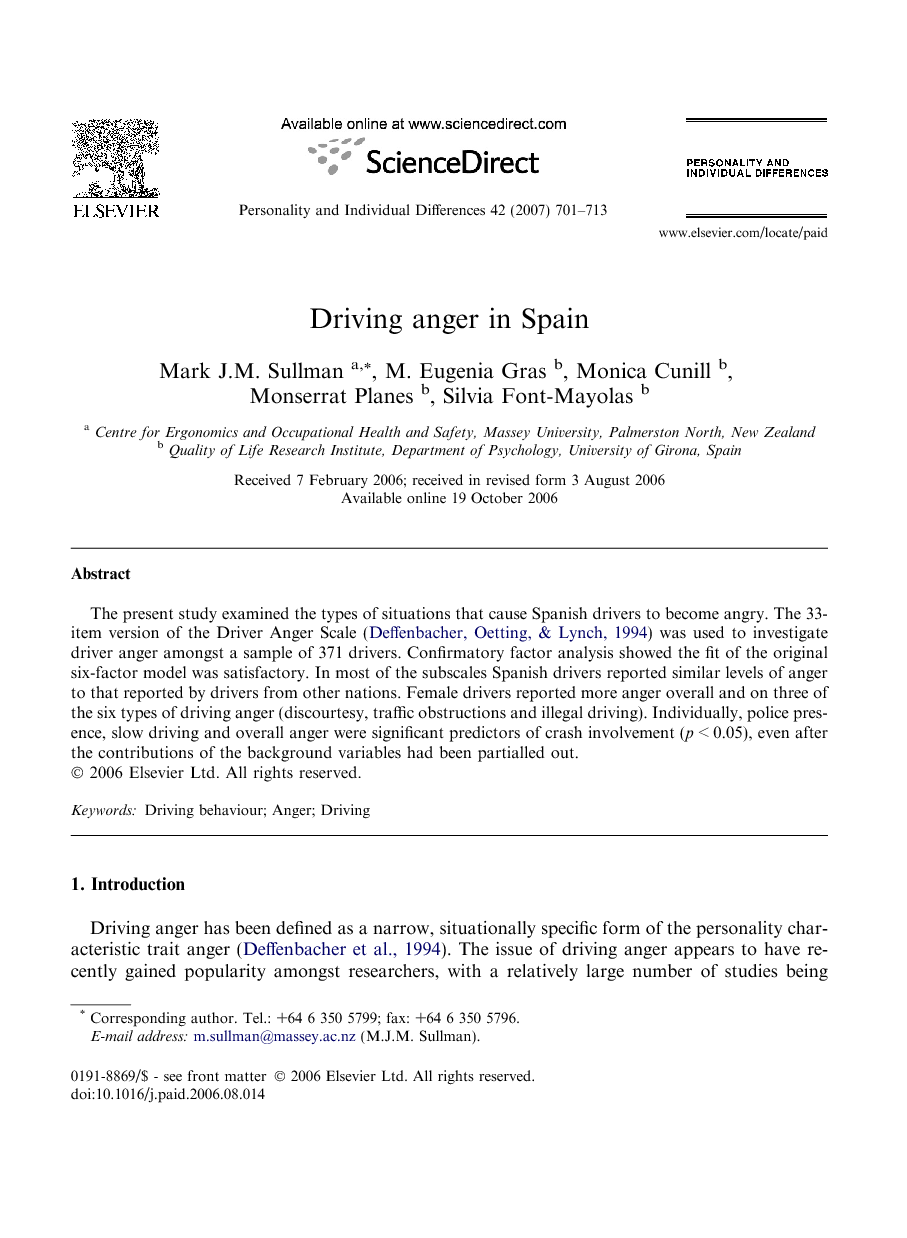خشم رانندگی در اسپانیا
| کد مقاله | سال انتشار | تعداد صفحات مقاله انگلیسی |
|---|---|---|
| 33301 | 2007 | 13 صفحه PDF |

Publisher : Elsevier - Science Direct (الزویر - ساینس دایرکت)
Journal : Personality and Individual Differences, Volume 42, Issue 4, March 2007, Pages 701–713
چکیده انگلیسی
The present study examined the types of situations that cause Spanish drivers to become angry. The 33-item version of the Driver Anger Scale (Deffenbacher, Oetting, & Lynch, 1994) was used to investigate driver anger amongst a sample of 371 drivers. Confirmatory factor analysis showed the fit of the original six-factor model was satisfactory. In most of the subscales Spanish drivers reported similar levels of anger to that reported by drivers from other nations. Female drivers reported more anger overall and on three of the six types of driving anger (discourtesy, traffic obstructions and illegal driving). Individually, police presence, slow driving and overall anger were significant predictors of crash involvement (p < 0.05), even after the contributions of the background variables had been partialled out.
مقدمه انگلیسی
Driving anger has been defined as a narrow, situationally specific form of the personality characteristic trait anger (Deffenbacher et al., 1994). The issue of driving anger appears to have recently gained popularity amongst researchers, with a relatively large number of studies being published in the last decade (e.g. Dahlen et al., 2005, Deffenbacher et al., 2003, Deffenbacher et al., 2001, Parker et al., 2002, Sullman, 2006a and Underwood et al., 1999). One of the reasons cited by almost all researchers on this topic is the reported increase in levels of anger and resultant road rage incidents. However, the evidence for an increase in driving anger is inconclusive with the only peer reviewed research on this topic reporting road rage had not increased in one region of Canada (Smart, Mann, & Zhao, 2005). Whether or not driving anger is increasing, there are a number of other reasons for studying this phenomenon. Firstly, to become angry whilst driving appears to be a relatively common event (Deffenbacher, Lynch, & Oetting, 2002). Furthermore, a number of studies have found that angry drivers engage more often in aggressive and dangerous behaviours (Dahlen et al., 2005, Deffenbacher et al., 1994 and Deffenbacher et al., 2001). Research has also found significant relationships to exist between driving anger and near misses (Underwood et al., 1999) and crash related conditions, such as losing control of their vehicle, losing concentration and crashing in simulator studies (Deffenbacher et al., 2001 and Deffenbacher et al., 2003). There are a number of ways in which driving anger can be measured, with one of the most commonly used scales being the Driving Anger Scale (DAS). The 33-item version of the DAS has been used to measure driving anger amongst drivers from the USA (Deffenbacher et al., 1994), UK (Lajunen, Parker, & Stradling, 1998), and New Zealand (Sullman, 2006a). Findings using the 33-item version of the scale have produced widely different results in terms of the underlying structure of the scale. The original research found six different types of driving anger (slow driving, traffic obstructions, police presence, illegal driving, hostile gestures and discourtesy), while research in the UK found that their data was best described by three factors (Lajunen et al., 1998). To further add to the confusion, Sullman (2006a) found that four factors best described the data he collected from a sample of New Zealand drivers. Interestingly, one factor, Hostile Gestures, was found by all three studies using the 33-item version of the DAS (Lajunen et al., 1998 labelled it “direct hostility”). There are a number of possible reasons for the differences in the factor structures found in the three previous studies. Firstly, there was the fact that Deffenbacher et al. (1994) analysed their data using cluster analysis, while the other two studies used exploratory PCA. Furthermore, Lajunen et al. (1998) dropped six items from their factor analysis as the situations without other motorists involved (e.g. you encounter a detour) evoked very little anger amongst the British drivers. This resulted in the production of a 21-item UK version of the DAS, as a further six items did not load on any of their three factors. It also seems possible that cultural differences between USA, UK and NZ may have contributed to the different factor structures. Unfortunately, the only peer reviewed study to use a version of the DAS to collect data from more than one country (Parker et al., 2002) used the 21-item British version of the scale, meaning that the study cannot be used as evidence of the 33-item scale’s factor structure. However, although there is no directly relevant research on the cultural differences in driving anger between these countries, there is evidence that suggests general anger scales translate across cultures with more divergent origins than those mentioned above (e.g. Krohne et al., 2002 and Maxwell et al., 2005). Therefore it appears that the differences in factor structure may have been caused primarily by dissimilar analytical approaches. Although there has been disagreement on the scale’s factor structure there has been a relatively high degree of agreement in the relationship between self reported driving anger and a number of background variables. For example, research has found that females generally report higher levels of driving anger and that the level of driving anger declines with age and experience (e.g. Parker et al., 2002 and Sullman, 2006a). Research has also found that drivers who reported preferring to drive faster also reported higher levels of driving anger (Sullman, 2006a). This study investigated driving anger in a sample of Spanish drivers. In particular the research investigated; the factor structure of the DAS using confirmatory factor analysis, which situations angered Spanish drivers, along with the relationships driving anger had with a number of descriptive variables.

